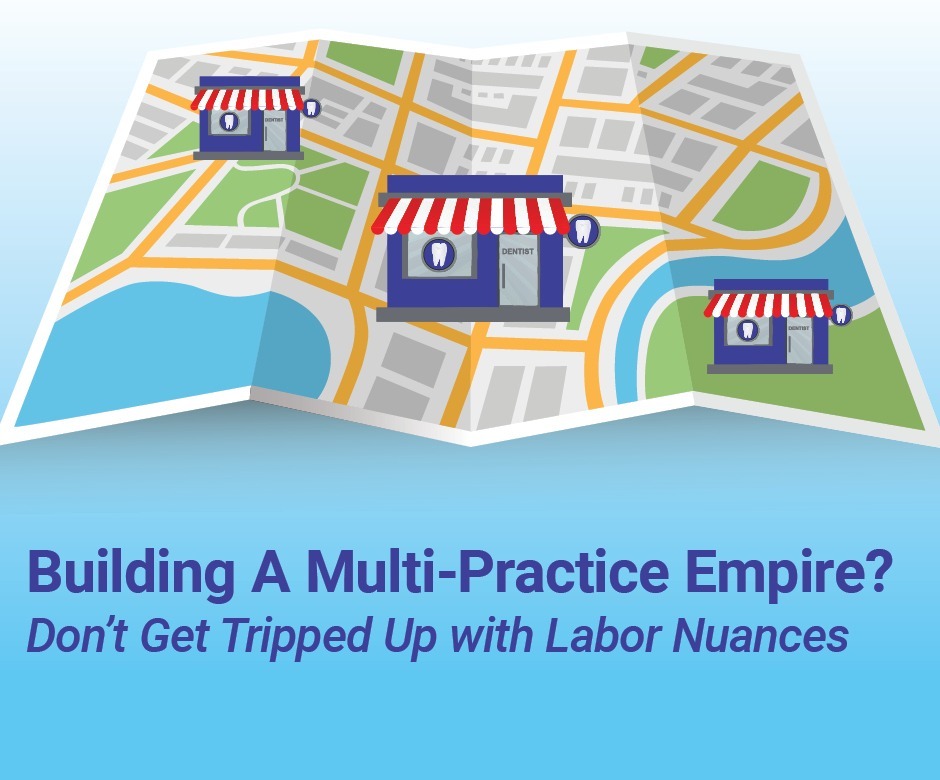With the increase in multi-location practices, as well as myriad ownership structures, it is important to know Human Resources regulatory (federal, state, and city/county) implications of owning multiple business locations.
Many applicable regulations vary based on the number of employees. A well-known example is the federal Family and Medical Leave Act (FMLA), which applies to employers with 50 or more employees, with the added wrinkle of specifically stating “50 or more employees within a 75-mile radius.”
Another example is Title VII of the Civil Rights Act, which is a federal law. This law protects employees against discrimination in the workplace for various reasons such as age, race, disability, pregnancy, and so on. Individual states will also have similar laws with employee threshold requirements; some are set at 20, 15, or even only one employee.
Each law may have requirements for an employer to adhere to. If not handled properly, employers can find themselves with serious liability in terms of lawsuits and/or claims with the Department of Labor. Knowing whether these laws apply to you is the first step in ensuring compliance and keeping liability at bay.
Which begs the question: How do you count the number of employees when there are multiple locations? Can you simply say, “My locations have separate tax ID numbers” and, therefore, your employee number is per location? Or do you have to add together all employees at all locations?
As with most things related to HR and employment laws, the answer is not quick and easy. And getting it wrong can have significant implications for your business.
For purposes of these HR regulatory laws, a multi-location practice must determine whether or not their entity is considered a single, integrated employer such that all employees are added together, no matter how far apart the locations.
To determine which category a business fits into, consideration is given to the following four factors:
- Integration Of Operations
- Common Ownership And Financial Control
- Common Management
- Centralized Control Of Labor Relations and Personnel
No single factor is determinative, yet the fourth factor is weighted most heavily.
Let’s look at a common example:
- A dentist owns three practices.
- Each location has its own tax ID number, payroll, and bank accounts.
- There is one regional manager who coordinates the employee management of all three offices.
- The regional manager and owner dentist perform all hiring and firing for all locations.
- All HR policies and benefits are standardized, and the locations share the same policy manual/handbook.
- Location A has eight employees, Location B has nine employees, and Location C has seven employees.
Evaluating this office, using the 4-factor test above, might look like this:
- Integration Of Operations: This may or may not be triggered, based on how much integration the practices have in their billing, insurance, supplies, and other operational aspects.
- Common Ownership And Financial Control: Since the sole owner is the one dentist, s/he exerts a common ownership and financial control over all three locations.
- Common Management: Since the Regional Manager and owner dentist are the primary controllers of the practices, the locations absolutely have shared management.
- Centralized Control Of Labor Relations And Personnel: Similar to #3, this one is triggered by the regional manager, owner dentist, and also the shared policy manual/handbook. Even if the employees don’t cross over and work at multiple practices, this factor is clearly triggered.
Since the fourth factor is weighted most heavily, and #2 and #3 are also likely true, this particular business meets the definition of a single, integrated employer; therefore, all employees are counted together to determine applicable laws.
Exploring how this scenario might impact the management of a business, imagine a practice with locations in Massachusetts and one with locations in Oregon. Each state has an unpaid sick leave requirement and a paid sick leave requirement based on employee number. For employers with more than 10 employees, sick leave is paid, and for employers with fewer than 10 employees, sick leave is unpaid. In order to comply one way or the other, the practice must determine which category their business is in. Is sick leave paid or unpaid? While in our scenario each individual location has an employee number below 10, the total number of employees as a single, integrated employer would trigger the requirement of paid sick leave.
One last example:
Let’s say these practices are in Minnesota, which has a parental leave rule that only takes effect if a business has 21 or more employees. While each location is well below that threshold, the total number of employees (8 + 9 + 7 = 24) is higher; and so, it is likely that each location, and all employees, would need to receive parental leave.
A common response is: “But these are separate businesses with separate tax ID numbers!”
That is true, and it has implications for tax purposes. But separate tax ID numbers is not the only determining factor the government uses.
There are plenty of other variables beyond those already discussed, such as locations in multiple states, joint ownership between two or more individuals, a few practices that are standardized along with a few practices that are each run individually, etc.
An additional layer of complexity is presented by state or local regulations and whether the verbiage speaks to how the calculation works. For example, the California Family Rights Act requires the business to count all employees in all states, while the benefit itself only applies to employees who work within the state of California. Unfortunately, many regulations do not clearly explain exactly how the employee threshold is calculated.
What should you do?
In most cases, it is safest to add up all employees at all locations and use that number for determining the applicable regulations for your business. While this might result in your business offering benefits you would prefer to avoid, in the long run this will likely save frustration and money (liability). The safe approach ensures you will not fall under scrutiny for denying benefits, and it will save you significant time and attorney fees in research.
If you feel strongly that all of your locations should be treated separately, then apply the 4-factor test above, and review each individual federal, state, and city/county regulation to determine how each rule calculates the employee number for that particular regulation. You would also look at every aspect of your particular business, including operations, management, decision-making processes, financial controls, etc. It would also be wise to compare the costs of simply providing any applicable benefits vs. the risk of getting it wrong.
As always, ignorance is not a valid defense when faced with a labor board claim or lawsuit. By educating yourself and following the basic suggestions in this article, you can protect your business and ensure long term success.

Alan Twigg is Vice President at Bent Ericksen & Associates with expertise in client consultations, strategic planning, marketing plan development, operational support, and product development.
FMI: www.bentericksen.com, info@bentericksen.com, or (800) 679-2760

